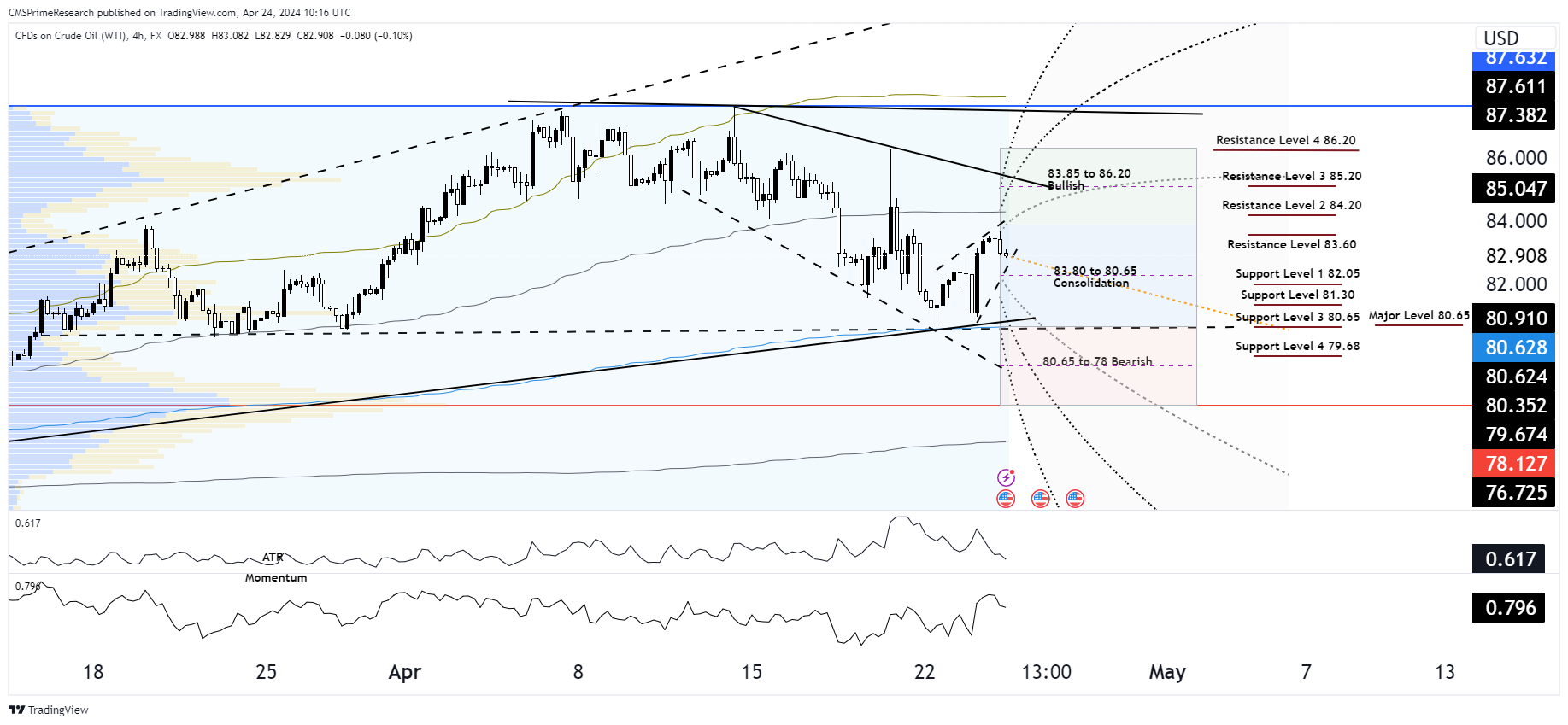
Current Factors Influencing Current Crude Oil Prices:
- Oil prices continued their upward trajectory on Wednesday following unexpected data showing a decrease in U.S. crude inventories last week, suggesting improved demand. However, market attention remained on the tensions in the Middle East.
- Brent crude futures increased by 22 cents, or 0.24%, reaching $88.64 a barrel, while U.S. West Texas Intermediate crude futures rose by 21 cents, or 0.28%, to $83.66 a barrel.
- According to sources citing American Petroleum Institute figures, U.S. crude inventories saw a significant decline of 3.237 million barrels in the week ending April 19, contrary to the expected increase of 800,000 barrels forecasted by six analysts polled by Reuters.
- Market participants await the official U.S. data on oil and product stockpiles, scheduled for release at 10:30 a.m. EDT (1430 GMT), to validate the substantial drawdown.
- In April, U.S. business activity saw a decline to a four-month low, as indicated by S&P Global’s flash Composite PMI Output Index, dropping to 50.9 from 52.1 in March.
- Analysts at ANZ noted, “This could strengthen the case for policymakers to implement rate cuts to support the economy.”
- Potential U.S. interest rate reductions might stimulate economic expansion and subsequently increase demand for oil, given the United States is the world’s leading consumer of the commodity.
- Despite ongoing concerns, analysts remain optimistic that developments in the Middle East conflicts will continue to provide support to the markets, although the impact on oil supplies remains limited for the time being.
- Heng Koon How, head of markets strategy for United Overseas Bank (UOB) in Singapore, commented, “Overall, crude oil prices are well supported around current levels by ongoing Middle East risk premium.” He added, “We maintain our forecast for Brent to consolidate at USD 90/bbl by the end of this year.”
Technical and Fundamental Analysis

Chart Overview and Price Action
Technical Analysis:
Trend Analysis: WTI crude is currently in a bullish trend, experiencing consolidation after a recent uptick. The price is fluctuating within an ascending channel, which typically indicates a continuation of the bullish momentum.
Support and Resistance Levels:
- Immediate Resistance: Near $83.85 to $86.20, where recent tops have formed.
- Key Support Levels: Positioned at $82.05 and $81.30, which have historically provided a floor for price dips.
Fibonacci Levels: Price action is navigating around key Fibonacci levels. The market is just above the 0.618 level (around $83.00), suggesting a potential pivot or reversal area.
Moving Averages: Prices have been hugging the upper Bollinger Band, signifying potential overbought conditions which could precede a pullback towards the mean.
Momentum Indicators: The ATR indicates stable volatility while momentum has dipped slightly, aligning with the consolidative behavior of the market.
Fundamental Analysis:
U.S. Inventories: A surprise draw in U.S. inventories is a bullish signal, pointing towards higher demand or lower supply than expected.
Interest Rate Outlook: The potential for U.S. interest rate cuts could be bullish for oil, as it might encourage economic activity and, by extension, oil demand.
Middle East Tensions: Ongoing conflicts in the Middle East pose supply risks, maintaining a risk premium in oil prices.
Scenario Forecasts:
Bullish Scenario (50% Probability): The unexpected decline in inventories and Middle East tensions could push prices towards the upper resistance.
- Price Targets:
- First Target: $85.20 (upper end of the bullish consolidation range)
- Second Target: $86.20 (recent high)
- Stretch Target: $87.63 (if geopolitical risks escalate)
- Price Targets:
Bearish Scenario (30% Probability): If upcoming U.S. stockpile data doesn’t confirm the API’s draw, or if interest rates remain unchanged, the price may retreat.
- Price Targets:
- First Target: $82.05 (first key support level)
- Second Target: $81.30 (second key support level)
- Stretch Target: $80.65-78 (bottom of the channel)
- Price Targets:
Neutral Scenario (20% Probability): Prices might consolidate further within the current range if the market adopts a wait-and-see approach ahead of more definitive data or geopolitical developments.
- Price Targets: Ranging between $83.85 to $86.20.
Overall Market Sentiment:
- Positive: 50% driven by lower U.S. inventories, potential interest rate cuts, and geopolitical risk premiums.
- Negative: 30% considering the chance of non-confirmation of inventory draws or stable interest rates.
- Neutral: 20% due to potential consolidation and balanced market forces.
Investors should be on high alert for the official U.S. oil and product stockpiles data release, as it will either confirm or counter the API’s figures, significantly influencing market sentiment. Additionally, any escalation or de-escalation in the Middle East will pivotally sway oil prices.
Price analysis and Targets:($86-$81)
Given the current oil price of $82.92, the observed market dynamics, and an Average True Range (ATR) of 0.895 indicating moderate volatility, we can establish a trading strategy that leverages this information to target potential upward and downward price movements. This strategy will focus on the bullish price targets of $85.20 to $86.20 and bearish targets of $81.30 to $80.65, based on the scenario forecasts and technical indicators described.
Strategy Components
1. Bullish Scenario Planning
- Entry Point: Considering the bullish momentum and recent inventory drawdown suggesting increased demand, initiate a long position if the price shows a clear bounce off the current level or breaks above a minor resistance at around $83.20. This provides confirmation of continuing bullish sentiment.
- Stop-Loss: Set the stop-loss at $81.90, slightly below the recent support level of $82.05. This placement limits downside risk while allowing some room for normal price fluctuations.
- Take-Profit Targets: Set the first take-profit at $85.20, aligning with the lower end of the bullish target. If momentum remains robust, consider adjusting or setting a second take-profit at $86.20, near the upper range of the bullish scenario.
2. Bearish Scenario Strategy
- Entry Point: In the event of a downward movement, especially if the upcoming U.S. stockpile data does not confirm the API’s reported drawdown, consider initiating a short position if the price breaks below $82.05. This break would indicate a shift towards a bearish trend.
- Stop-Loss: Place the stop-loss just above the recent minor resistance turned support level at $83.20 to cap potential losses should the price unexpectedly reverse upward.
- Take-Profit Targets: The primary target for a bearish move would be $81.30, with a stretch goal to capture further downside at $80.65, aligning with the lower end of the bearish price target.
3. Monitoring and Adjustments
- Economic and Inventory Reports: Keep a close watch on the release of the official U.S. oil stockpile data, as well as any developments in geopolitical tensions in the Middle East. Be ready to adjust strategies according to new information, which could significantly influence market sentiment and price movements.
- Technical Reassessment: Regularly review the momentum indicators and ATR. If volatility increases beyond the current ATR of 0.895, consider adjusting stop-loss and take-profit settings to accommodate the increased movement.
- Position Sizing: Given the volatility, manage risk by adjusting the size of the trading positions to ensure they do not exceed a prudent percentage of the trading capital.
Additional Considerations
- Volatility Management: With an ATR of 0.895, expect daily price swings that could test both the proposed stop-loss and take-profit levels. The strategy should include a provision for possibly tightening or widening the stop-loss and take-profit orders based on actual market volatility.
- Market Sentiment Updates: Stay updated on market sentiment through financial news and analysts’ reports, particularly focusing on the oil market’s response to U.S. economic indicators and Middle East geopolitical events.
This strategy is designed to exploit potential upward and downward movements based on the current market conditions and technical setups by making strategic entries and exits at defined support and resistance levels. Adaptability and close monitoring will be crucial in navigating the expected market conditions over the next five trading days.
To know more about CMS Prime visit us at https://cmsprime.com
Disclaimer: This is not an Investment Advice. Investing and trading in currencies involve inherent risks. It’s essential to conduct thorough research and consider your risk tolerance before engaging in any financial activities.


